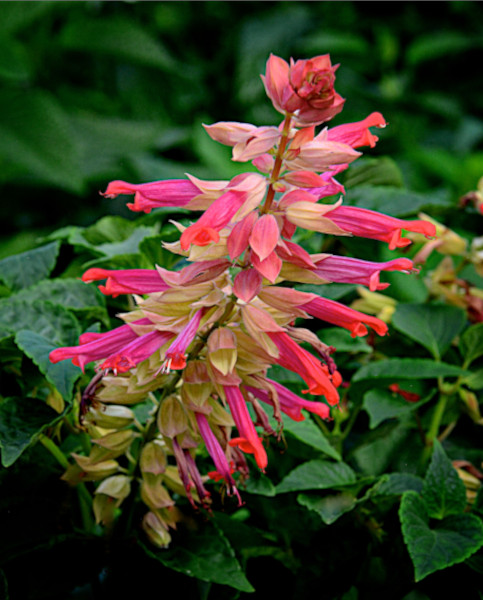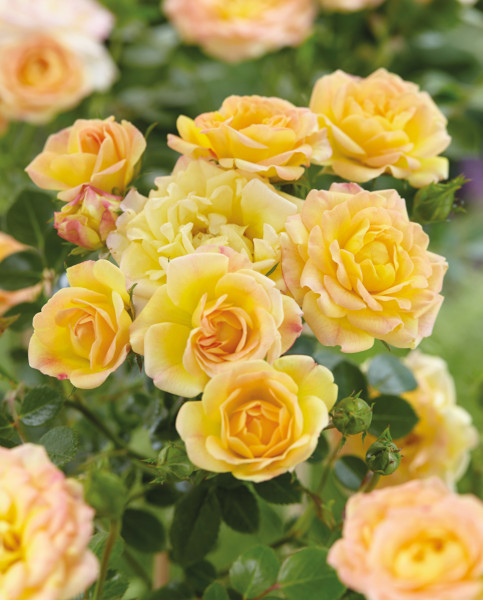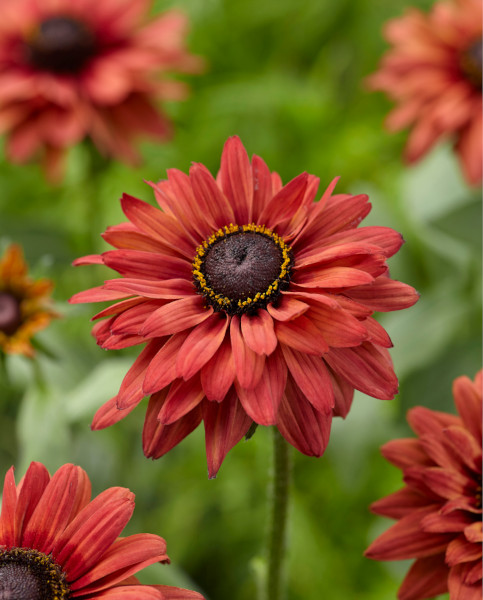How to grow Salvia
Salvias are a large genus of plants belonging to the mint family which flower for months on end during summer and come in a rainbow of gorgeous colours as well as a range of forms. There are the airy and delicate stems of the smaller flowered varieties, to more upright flowering plants such as the well-known deep purple variety Amistad. The distinctive velvety, two-lipped blooms are adored by bees and butterflies.
Salvia are valuable plants for the garden or pot, providing colour all summer long with very little maintenance and returning year after year. They are also easy to propagate.
Most Salvia grow to an approximate height and spread of between 60-90cm making them perfect for edging cottage garden borders where their scented foliage can be enjoyed, or for underplanting taller shrubs.
Salvia are available as annuals, biennials, and perennials and although they prefer a sunny site, they are tolerant of a little shade.

Key Information
Soil pH
Position
Hardiness


Where & when to plant Salvia
Position - Full sun to part shade
Soil - Any type, well-drained
Flowering Period - Early summer to autumn
Hardiness - Tender and hardy varieties available
Consider the height and spread of your Salvia before choosing a planting site which should be in full sun to part shade.
Dig a hole twice as wide and deep as your potted Salvia and add a good layer of organic matter to the planting hole - homemade compost or well-rotted cow or horse manure is perfect. A handful of chicken manure pellets will also provide a great slow-release fertiliser for your young plants.
You should also add a handful of grit to the bottom of the planting hole if drainage on your soil is poor or you are growing in heavy clay as Salvias prefer to be kept on the dry side.
Gently tease your Salvia from its pot and loosen the roots a little before placing in the hole with the top of the root-ball just level with the surface of your soil. Back fill the edges with soil and firm around the base of the plant before watering in well.
How to plant Salvia
Dig a hole twice as wide and deep as your potted Salvia and add a good layer of organic matter to the planting hole - homemade compost or well-rotted cow or horse manure is perfect. A handful of chicken manure pellets will also provide a great slow-release fertiliser for your young plants.
You should also add a handful of grit to the bottom of the planting hole if drainage on your soil is poor or you are growing in heavy clay as Salvias prefer to be kept on the dry side.
Gently tease your Salvia from its pot and loosen the roots a little before placing in the hole with the top of the root-ball just level with the surface of your soil. Back fill the edges with soil and firm around the base of the plant before watering in well.

What to plant with Salvia
From rich jewel to soft pastel tones, with large or dainty blooms, there is a Salvia to fit into any modern or traditional planting scheme. Vibrant coloured Salvia look dramatic and colourful when grown next to plants with dark foliage such as Cannas, dark-leaved Dahlias and Bronze fennel. As a species Salvia are fairly drought tolerant and will work well in a dry garden planted next to other plants and grasses which thrive in similar conditions. The aromatic foliage of Salvia means they can be useful to repel pests. Try planting lower growing varieties under your roses to deter aphids. The herb Sage is a well-known variety of salvia and is sometimes grown in this way.
Below are a few suggestions of plants to grow with your Salvia.
Tropical planting scheme:
Cannas, Dahlias, Hostas, Cosmos, Alstroemeria, Agapanthus, Ferns, Banana, Fatsia, Acanthus mollis, Ginger
Prairie/dry garden:
Echinacea, Lavender, Bronze fennel, Sanguisorba, Verbena bonariensis, Gaura, Alliums, Nepeta, Rosemary, Eryngium, Euphorbia
Cottage garden:
Heuchera, Geums, Hardy geraniums, Foxgloves, Clematis, Roses, Antirrhinums, Phlox, Rudbeckia, Penstemon, Astrantia, Scabious, Bearded Iris, Alchemilla mollis, Peonies, Delphiniums
Salvias really are a stalwart of many garden planting schemes and can be used to enhance your plantings schemes in whichever way you choose. An investment in these airy and delicate forms will be most rewarding.



How to care for Salvia
Deadhead faded blooms to extend the flowering season of your Salvia. Plants can also be cut back by a third in midsummer to promote fresh growth and a second flush of blooms.
Salvia grown in the garden do not need regular feeding, although a mulch with spent compost in autumn is beneficial as protection against cold winter conditions and to suppress weeds. Watering is also not usually necessary unless during periods of drought.
Particularly tender varieties should be lifted in autumn and overwintered in a greenhouse for frost protection. For this reason, these types of Salvias are well-suited to pots which can simply be relocated without the need for digging.
Annual Salvia can be pulled out in late autumn and composted. They can easily be grown from seed next spring.
Hardy perennial Salvia should be cut back in autumn to a few inches from the ground before mulching.
How to propagate Salvia
Salvia can be grown from cuttings taken in late spring or late summer.
Use a sharp knife to remove non-flowering shoots approximately 8cm long, just below a leaf node. Remove the tip of the cuttings and the lower pair or two of leaves. You should do this in the morning when your plants are well hydrated.
Dip the bottom of the cuttings in hormone rooting powder and pot your cuttings immediately into a small pot of compost with added perlite or grit. You can place 3 or 4 in each pot, around the edge.
If you are not able to pot the cuttings up straight away, then place them in a plastic bag sealing the air and moisture in if you can until you are able to pot them up, they are best not left for too long however.
Once potted up, water your pot and place it on a warm windowsill or in the greenhouse. Keep the humidity levels high with regular misting or place a small clear plastic bag over the top for a week or two.
Once you can see roots appearing at the bottom of the pot, your Salvia cuttings are ready to be grown on. Carefully tip your cuttings out without disturbing the roots too much and pot each one into its own container of compost to grow on, ideally in a greenhouse, before hardening off and planting outside next spring.
Common Salvia questions
Are Salvia plants poisonous?
There are several edible varieties of Salvia used in every day seasonings. The ornamental varieties do not taste very pleasant, and are listed as non-toxic for children, adults and pets.
How many types of Salvia are there?
Including annuals, perennials and shrubs, there are reported to be over 900 different species of Salvia.
How often should I water Salvia?
Generally, Salvia need regular watering, especially during dry or drought conditions. Established plants are usually more drought tolerant.
Can Salvia survive winter?
Many perennial Salvias can survive winter, especially in well-drained soil, in milder climates. In much colder areas, some plants may require protection over winter - some gardeners grow them as annuals.





